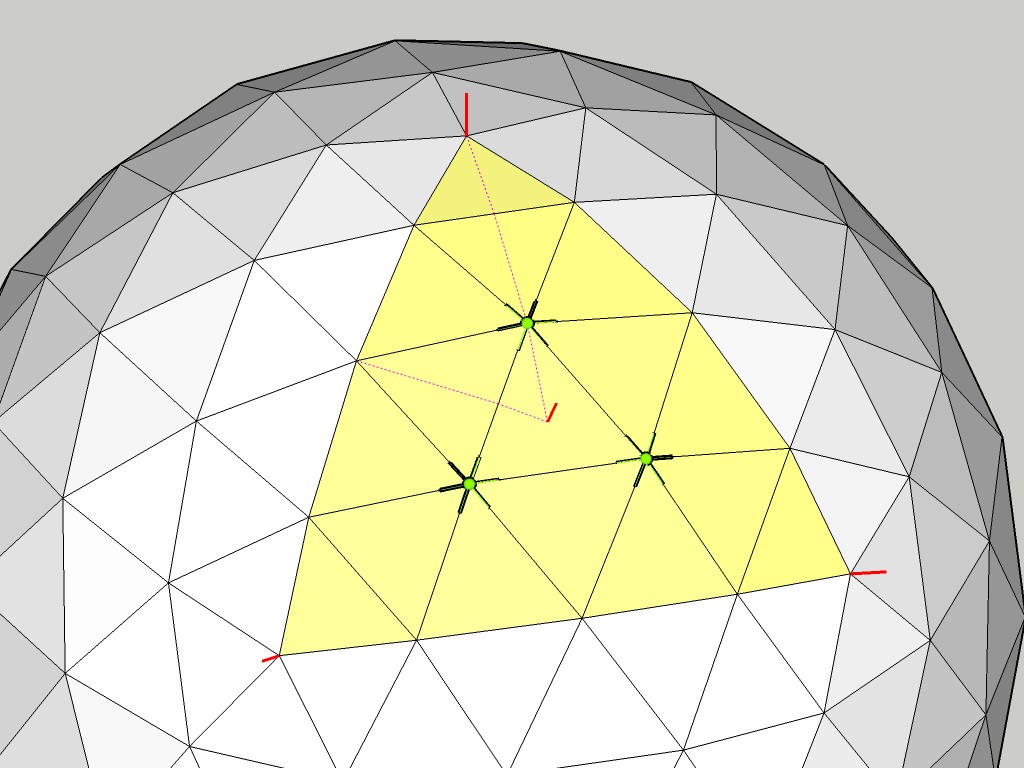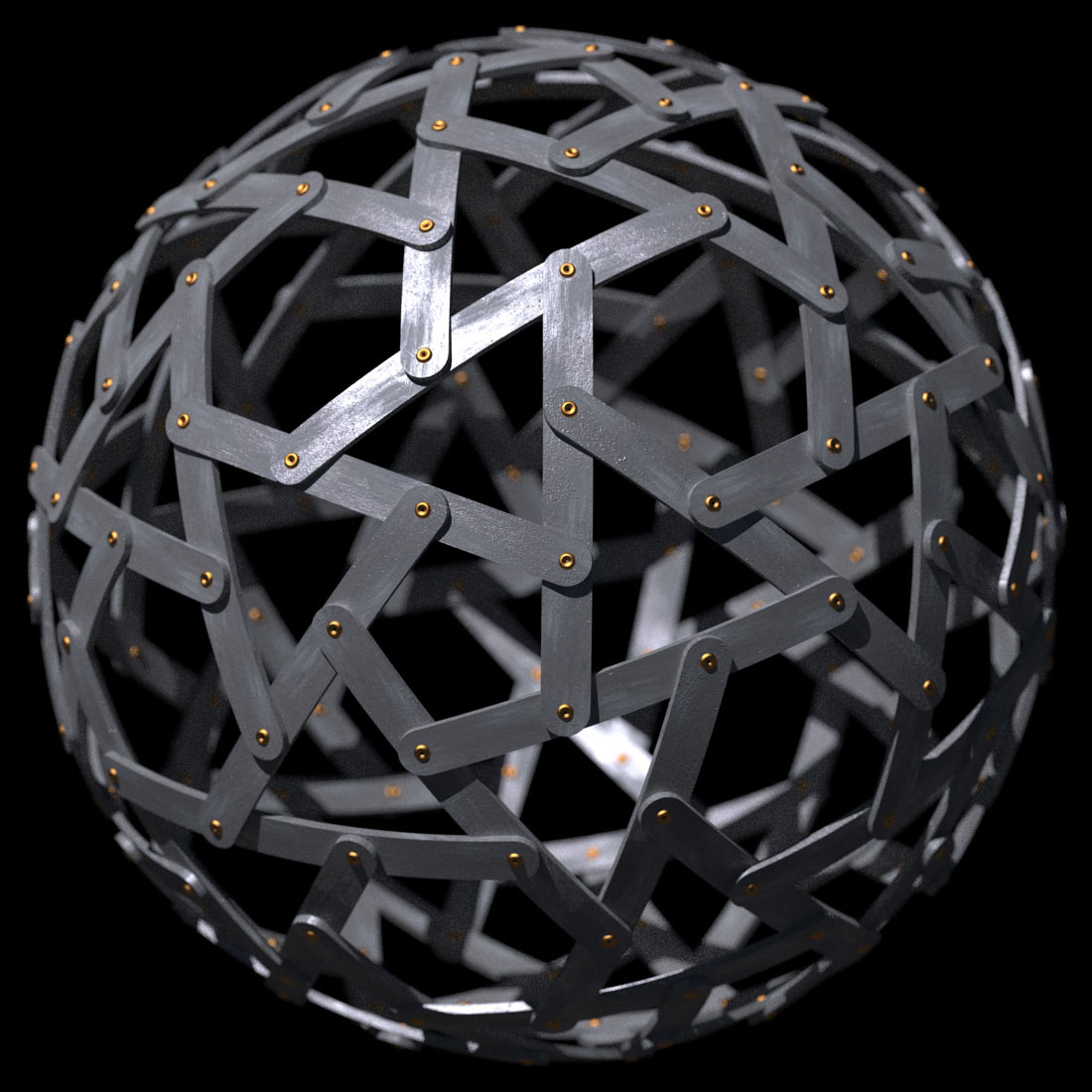A simplified SketchUp model is available:
Gears Ball- 3D Warehouse
%(#BF0000)[(Clickable image-link, to deviantART ]
]

~Taff
A simplified SketchUp model is available:
Gears Ball- 3D Warehouse
%(#BF0000)[(Clickable image-link, to deviantART ]
]

~Taff
@slimdog said:
How do all the axles come together in the middle?"
It's a virtual model -- so, no axles.
@unknownuser said:
Where does the drive motor fit in?"
It's a virtual model -- so, no motor.
@unknownuser said:
So no sketchy physics plugin was used?"
So, no....
If I were to physically build this, as a sculpture, I'd use an internal geodesic frame/cage, where I'd mount 92 short axle "spindles," pointing outward, at the geodesic vertices.
Only one gear would need to be powered, as all the rest would be "pushed" by that one gear.
Mounting an electric motor, hidden inside the cage, would be trivial.
How to keep kids from sticking their fingers in the gears - now, THAT would be a problem. (I suppose, the adults, too.)
~Taff
@unknownuser said:
I just sent you the money you demanded as well...
So, the subliminal programming worked, then. 
Mwah-ha-haaaa... 
@bob-designer said:
Very interesting, what else would I expect from you?
If you do a quick check of my online history, you'd then know "what," indeed.... 
@castromann said:
there has to be a lot of thinking behind this one. i saw your geodiscs and models in the warehouse before. where does your addiction to geodiscs come from - seems like your obsessed by these
I beg your pardon! - OBSESSED ? 
I rather prefer "enamored," if you don't mind.
( "Smitten," "enchanted," "infatuated" or "enraptured" will also do )
~Taff
It's been 40+ years of fascination with the geometry & mathematical derivation of the elements of geodesic domes, which used to be closely-guarded proprietary information.
I did this to demonstrate that a proper arrangement of gears, in a sphere, could, indeed, rotate.
There was some conjecture (in another forum) that the counter-rotation of gears would be locked. Truly, if three adjacent gears were meshed together, then the whole system would lock-up. This image settles the argument! "A picture is worth a thousand words."
Producing the proper association, of a gear and it's neighbors, will ensure that it won't be a locked system.
~Taff
Nice Twilight render, Martin. That was quick (and, I hope, painless?)
I looked over your model, and particularly like scene 4 (but I'm geodesically biased.) I changed some of the SU view settings, to display the "copper" cables:

It would be nice to be able to render a photo-realistic image that produces the "glint" from the dome frame, as in some of the movie stills, but I don't think that render engines are implemented to provide reflections from "edges." (The outer copper cables, in my model, are just edges, and it's my understanding that render engines are set-up to render faces.)
I suspect, that nowadays, this movie prop would never have been built, as CGI would be employed, instead. Gone are those days, not so long ago....
-Taff
Martin,
I look forward to seeing your progress, as you refine your model. You may note that I've added your model to my "Geodesic" Warehouse collection.
For those of you, not familiar with the details of the "Valley Forge," Martin & I have, both, been using this excellent website, which details props from the movie:
In particular, I used these two photos, in my research:


What I found particularly surprising was that the (1972) movie preceded the building of the Antarctic dome (1975,) yet, the skeletal framework for both domes is virtually identical, both in geodesic subdivision and profile (height/width ratio.)

-Taff
Martin,
I apologize if I gave the impression that it's about credit. I certainly don't mind if you use the dome & pod model files I emailed you, to upgrade your model, with or without attribution.
I always strive to encourage modelers, by providing geodesic support. That's my "thing."
I'm chagrined that you may have taken my emails as criticism. That was not my intent.
-Taff
@mhtaylor said:
I've already heard from geodesic dome experts that the both greenhouse domes and the fuel cells at the rear aren't correct but I don't currently have the energy to go back and rework them.
I was only trying to help,...


...honest!
(I did provide my SU files, BTW.)
-Taff
Thanks, Fletch. You're gracious for saying that.
I'm currently playing with render-material variations, myself...

-Taff
Today, I posted the model to the Google 3D Warehouse • Rotegrity Springs

The posted version has been updated, to reflect the latest changes; to adjust/refine angles & follow-me paths. I'll keep the Warehouse edition updated, so you only have to look there for the latest changes (although, I think I've found all errors, and refined it as much as I can.)
-Taff
In addition, you can make it easier on yourself (editing,) by taking advantage of layers, to hide/show particular elements of the model. (Examine attached.)
-Taff

Replicating geodesic elements around a sphere can be difficult, if you don't know about SketchUp's ability to rotate around any axis you choose, rather than just the 3 primary axes.
You should benefit from reading:
http://sites.google.com/site/sketchupsage/tweak/rotate
...and, perhaps,...
http://groups.google.com/group/geodesichelp/web/taking-measurements-from-geodesic-models?hl=en
Both demonstrate how to use the "Rotate" & "Protractor" tools, taking advantage of axis selection, by dragging.
You can also do yourself a favor, by rotating the entire model, so that the axis through one of the pentagon-center vertices is aligned straight up, along the blue axis. I've attached your model, with this change.
Also, in the model, I've highlighted "mirror" guidelines, inherent to each icosahedron face. You can take advantage of a mirror plugin, to replicate some of the hubs. By examining the mirror lines, you should be able to see that an icosahedron face can be divided into 6 equivalent triangles (although half of them will be mirrored.)
I've drawn in an additional central axis, that can be used for rotations. By mirroring & rotating, you should be able to place hub components precisely where you want them, using 72 and 120 degree rotations, only.
You should note that all of the hubs will not share the same "face angles." The tubes will not align with the edges, unless the hub components are modified to fit the edge angles. Based on mirroring & rotating, you will need 4 unique hubs, for this particular geodesic tessellation (frequency 4.) A complete "population" of the dome, with hubs, will use copies of only these four hub versions. (Again, some will be mirrored.)
Once you have one icosahedral face populated, you can copy them to an adjacent icosa face, by rotating them around one of the RED axes, located at each icosa corner (72-degree rotations.)
One of the tricks, which I use, is to make an icosa face a component. Any changes to the primary icosa face component will automatically be replicated in the remaining 19 icosa faces.
-Taff

@unknownuser said:
Years ago I helped re-assemble the Dymaxion House,..."
What a rare opportunity!
For readers who may wish to pursue their own rendering ideas, here's the model:
@notareal said:
Taff, your work is truly inspirational.
Thank you, for writing such a gracious compliment.
I know that you, in particular, can also appreciate that I used Kerkythea to render this model. Thanks for the knowledge I gleaned from the Kerky forum -- information you provided in your posts there. Without that, I would not have been able to figure out, on my own, how to use the abundance of settings available in KT.
This render is a little better than those that I previously posted above. (Kerkythea; Path-tracing - Progressive; no Photoshop post-processing)
-Taff

@simon le bon said:
How many are you all over the world to accomplish that sort of geodesic stuff?
I've wondered that, myself. I've been doing geodesic stuff for 30+ years. No one had ever heard of me, until I became involved in SketchUp, and started posting to the 3D Warehouse, my own Google Group, and here. (Even with that, it's pretty limited exposure.)
So, how many other geodesic aficionados/creators are out there? There could be dozens-to-thousands, but with little-to-no exposure.
You'd think that there would be a good job market, since there are so few of us, but supply-and-demand apparently doesn't support that thesis. (Too bad. I'd love to do this as a career!) I've consulted a few times, but, as far as paying the bills, it's been disappointing.
I've been trying, with my postings, to increase the availability of 3D geodesic models, free on the internet. Perhaps, this will influence young, budding architects, and we'll see more geodesic domes/spheres used in architecture and art. Unfortunately, it's rather difficult to quantify cause-and-effect. I can only hope that I've inspired somewhat, and that the influence will be geometric, rather than just arithmatic.
By the way, the guy (Dustin Feider) who builds geodesic treehouses, in California, used one of my designs, and we corresponded by email:
Google search results
-Taff

Actually, this model shares the geometry of the two images, below. While keeping the same underlying geometry, I can get creative with the connected "bones" of the structure.
That said, devising the original geometric template did, indeed, take alot of thought, and several procedural trials, until I got it right. Once that was fait accompli, it has been more like "playing" with concepts, rather than work.
I've still got (at least) one remaining idea that I want to try, using this geometry template.
-Taff

